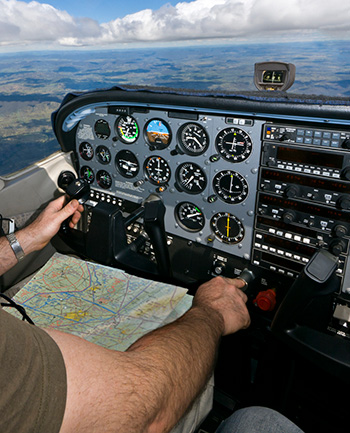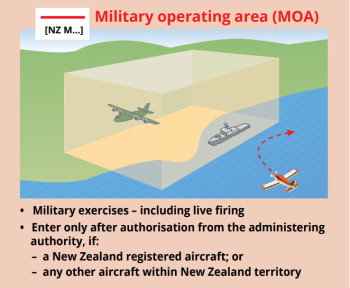These are three potentially lethal reasons for pilots to stay well clear of military operating areas.
At Ardmore aerodrome, south of Auckland, there’s been a recent increase in itinerant pilots drifting into the nearby military operating areas (MOA), marked M201 on VNC C6.
The proximity of the MOA boundary to the eastern circuit approach is one factor that catches out itinerant pilots at this busy unattended1 aerodrome.
The New Zealand Defence Force uses the MOA, intensively, 24/7. This means any aircraft straying into the restricted area puts itself at high risk of an occurrence, according to the NZDF and airport management.
Even pilots who are familiar with Ardmore aerodrome can stray into the MOA if they lose situational awareness in the circuit.
Jacob’s bad day

Ardmore MOA is one of 27 military operating areas across New Zealand. They’re depicted on visual navigation charts by the letter M, followed by three digits. iStock.com/mikulas1
Jacob – not his real name – is a case in point. He operates a helicopter charter business in the upper North Island, and he regularly flies in and out of Ardmore.
On this day, though, his tour group asked him to pick up a passenger at Ardmore on what should have been a direct flight from Hamilton to Waiheke Island. This abrupt change of plan, combined with the fact that Jacob was now approaching Ardmore from the south-east (different to his usual flight path into the circuit), affected what happened next.
“My whole routine changed, and there was a lot going on in the cockpit, with several passengers on board,” Jacob says.
“I know where the MOA is, but this time it was on my right-hand side when I flew into the circuit. I hadn’t taken time to take stock of the situation, and that’s why I ended up in the MOA.”
When Ardmore UNICOM contacted Jacob later to talk through the airspace breach, he realised why he had lost situational awareness.
“I had become a bit blasé. I wasn’t paying enough attention to the route, I was more concerned with finding my slot in the sequence.
“When it became clear there was a passenger to pick up at Ardmore, I should have paused to reassess the situation and get more details about the approach into the circuit.”
It’s not just Jacob

Source: New Zealand airspace GAP booklet
Jacob’s not alone in recently straying into the Ardmore MOA.
“The data’s clear,” says Allan Bostock, the General Manager of UNICOM at Ardmore Airport. “There have been five occurrences in the last few months – by both fixed-wing and rotary aircraft. There were 10 occurrences in the two years before that. It’s almost invariably itinerant pilots who drift into the MOA.”
He explains that the boundaries of the Ardmore MOA were expanded a few years ago, in consultation with aerodrome users.
“This brought the MOA boundary parallel to our downwind leg, about two nautical miles from our runway. And the height restriction went from 1700ft to 2300ft above sea level. It’s quite a big area. Pilots should avoid tracking between Waterworks and Red Hill visual reporting points.”
He says itinerant pilots coming from the south and south-east are more likely to stray into the MOA, because of its location relative to the circuit.
Live fire, explosives training, drones
“MOAs are designated spaces where the NZDF conducts training and exercises,” says Brett Arnold, the Battle Training Facility Manager at the Ardmore Military Training Area.
“This could include live firing, the use of explosives, and non-notifiable UA (unmanned aircraft) operations. Unauthorised aircraft must keep out of these restricted areas at all times.
“The Ardmore MOA is active 24 hours a day. It has live fire rifle ranges, and areas where we conduct explosives training. For example, if an aircraft is flying through the MOA, and a rifle round ricochets off something, it can go into the airspace at altitude with great velocity. This could be disastrous if it strikes an aircraft. The sites are designed for that not to happen, but there are no guarantees.”
Explosives training also presents a potentially lethal hazard to aircraft flying in the MOA. Brett says blasts from explosions can create a shockwave that, when deflected off an angled piece of terrain, can bounce upwards into the path of an aircraft, creating turbulence, and potentially forcing it off its flight path.
Military UAs are another threat to aircraft entering the MOA.
Brett says training has to stop when an aircraft breaches the MOA, until clearance is given. NZDF personnel spend a lot of time monitoring flight radar apps and tracker information, and reporting breaches of the airspace to UNICOM.
Tips for pilots
The CAA’s Andy McKay, a flight examiner and rotary-wing pilot who regularly uses Ardmore aerodrome, offers these tips to pilots:
- Do your preflight prep. Study the layout of Ardmore and its surrounding airspace. Understand the location of the MOA relative to the circuit and note visual landmarks to help maintain separation.
- Where possible, brief yourself on the likely circuit traffic pattern before you arrive, using Ardmore’s AWIB and information from local operators.
- Use tools like GPS or electronic flight bags (EFBs) to display the restricted area on your navigation screen.
- Plan your approach to the circuit well in advance. Determine your anticipated entry point and route, keeping in mind the location of the restricted area.
- Fly a well-defined and predictable circuit, in line with the published procedures.
- If you lose situational awareness, focus on maintaining separation from other aircraft and avoiding the MOA.
For Jacob, the incident has changed his flying behaviour. He’s learned to say no to customers who ask to divert at short notice.
“If I don’t have time to go through the proper process, I say no. It’s more important to get the job done safely than to accommodate last-minute requests from the customer.”
More information
New Zealand airspace Good Aviation Practice (GAP) booklet [PDF 1.5 MB]
Footnotes
1 Ardmore has a UNICOM service – see:
Vector Summer 2023 [PDF 6.4 MB]
Main image: The Puma UAS being launched by hand as part of a military training exercise. Photo courtesy of NZDF.
